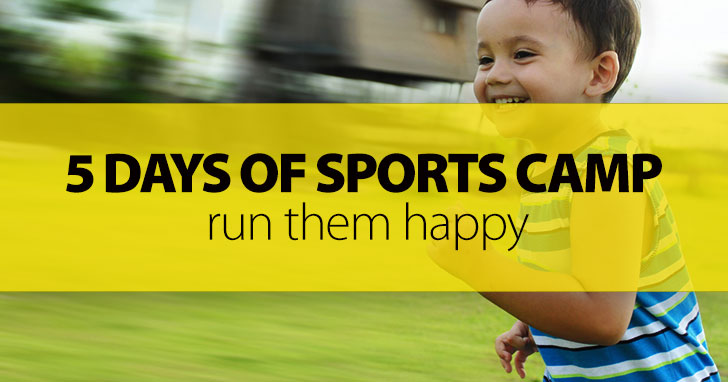
For those teachers who are required to teach summer and winter English immersion camps, it can be difficult to come up with viable ideas that will hold the attention of students who are more likely than not only semi-willing participants in this interruption of their vacation time.
Depending on your school, chronic tardiness, absence, and apathy can take a significant toll on your camp. The solution? Motivate those students with sports time! A sports camp is a great way to get your students moving around and help them forget that they are actually in school.
A quick disclaimer: this type of camp can be adapted for any English level, but it is very difficult (especially through a language barrier) to motivate students who hate sports to participate. If you have several non-athletic types in your camp group you will have to be very careful to select sports that they can be successful at or, if necessary, avoid sports camp completely.
Basically, there are two different ways to approach this project. One is to pick a great sport that you like and know well (preferably one that the students don’t know much about) and spend the entire camp building their skills, understanding, and vocabulary around this single sport. That concept is discussed elsewhere on BusyTeacher.org as an after school class idea, so I will confine myself to the second method. This method is one where they learn/practice a different sport every day. Most of the days will follow a similar format with the exceptions of the last day so I will lay out what that format will look like (I assume that most camps will consist of four, forty-five to fifty minute periods).

How to Teach a 5-Day Sports Camp
-
1
First Period: Warm-up and Vocabulary
By warm-up I mean English warm-up, not jogging and stretching. That comes later, as the focus of these camps is, after all, English. These warm-ups can be as simple as a crossword or an English based quiz game. Anything to get the students back into thinking about and using English.
Then you teach them the basic vocabulary that they will need. This falls into two categories. Most important is the vocabulary that they will use for on-field communication. This is the material that they will be most interested in. Second is the vocabulary that they will need to understand the rules and the playing area. As the camp progresses, much of the vocabulary will be repeated, so this section can move away from the teacher speaking and towards scavenger hunt or crossword games where the students discover the necessary vocabulary.
-
2
Second Period: Rules and Regulations
Introducing the sport is really important. Teachers need to show enthusiasm and get the students excited to play. A great way to do this is to show highlight clips for the sport if there are any available. Then explain the rules. Although this seems simple, teachers should start thinking about this well ahead of time and be sure that they are using the simplest version of the rules and the easiest language to explain them. A great thing about sports camp is it can interest some students who are usually apathetic towards English, but this means that explanations must be kept very simple to allow these students to follow them.
Once the basic explanation is completed in the classroom, it’s time to take the students to the playing area and start to demonstrate the rules. It is important that this is very structured. Teachers will either have a volunteer student work with them, or, if possible, have the co-teacher model the rules. Run through each rule and give an example of fair-play and a foul. After each example ask the students whether it is fair or foul. If there is time, have students pair off and give examples of a foul based on a rule that the teacher calls out.
It should also be pointed out that there are only forty-five minutes in this period and that will limit the complexity of the rules that can be explained and, by extension, the sports that can be taught. American football, for example, is far too complicated to be taught at a sports camp.
-
3
Third Period: Drill Time
Because these sports are unfamiliar, some of the students will need time to practice some of the necessary skills. Almost every sport has a relatively small set of absolutely essential skills and many practice drills for these can be found online. Select two or three basic skills. Model them one at a time and have the students practice them (if possible) by themselves or in pairs. Once they have had a few minutes of playing with these skills stop them and introduce a larger drill to practice these target skills. At this point teachers should also be emphasising when to use the on-field vocabulary that the students learned in the first period. For example, calling ‘Here, I’m open!’ when they are ready for a pass, ‘Look deep!’ if they are free downfield, or whatever vocabulary is necessary to play the game. This should be a required part of each drill and make the students stick to it! It’s easy for them (and the teacher) to get caught up in just practicing the sport, but everyone needs to remember that this is English camp.
-
4
Fourth Period: Play It!
The most important part of the day: play the game! This is why the students signed up for camp. It’s important that the teacher watches during the drills to see where the different skill levels are and creates teams that are relatively even. A blow-out is no fun for anyone. Before the game starts, gather the students and have them recap the rules and emphasise that communication on the field should be in English. Depending on the level of the class, the teacher may want to introduce a card system similar to soccer. The first time a student speaks their native language on the field, they receive a yellow card and their team loses a point. A second offense results in expulsion from the game. As a general rule there is no point in trying to regulate the conversation on the sideline; the students are too excited to focus on English when they are not actually playing. It may be best to introduce this element partway through the camp to allow students time to get comfortable before adding more pressure.
Sports camps a great time for all involved and it doesn’t hurt for the teacher to get in there and play.
Just remember that it is about the students, not about you. Also remember that playing the games is why most students signed up and because of this, they are likely to be excited, talkative, and squirmy during the early part of the day. There is a good chance that your classroom will be noisier than usual and you should plan accordingly. Most of all, remember that they are here to have fun as much as learn English and you might as well join in the laughter!
P.S. If you enjoyed this article, please help spread it by clicking one of those sharing buttons below. And if you are interested in more, you should follow our Facebook page where we share more about creative, non-boring ways to teach English.







